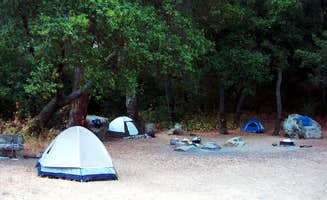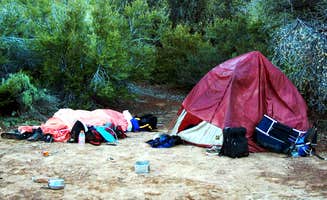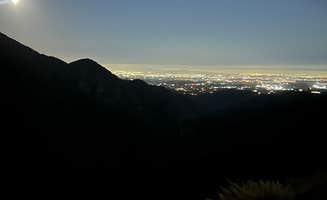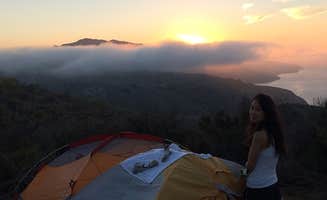Dispersed camping opportunities near Thousand Oaks, California primarily concentrate in Los Padres National Forest and Angeles National Forest, with elevations ranging from 1,500 to 5,000 feet. These locations experience significant temperature variations between seasons, with summer daytime highs often exceeding 90°F while winter nights can drop below freezing at higher elevations. Most primitive sites require adequate clearance vehicles to navigate unpaved forest roads.
What to do
Hike to waterfalls and swimming holes: From Big Cone Camp - Santa Paula Canyon, visitors can access natural water features. "This is a fairly easy hike through what would not be considered a typical hike. It starts off going through Thomas Aquinas College, winding through horse property and oil fields, before finally opening up into Santa Paula Canyon," notes one camper about the approach to swimming spots.
Take an island hiking excursion: The remote Del Norte Backcountry campsites on Santa Cruz Island connect to an extensive trail network. A camper reports, "Hiked from Scorpion Harbor cross-island to Del Norte Camp, great way to see the island. Camped at site 1, had the most wind but also the best views of the ocean."
Enjoy stargazing and night skies: The Angeles Crest Highway pullouts provide excellent dark sky viewing opportunities away from city light pollution. Bring warm clothing as temperatures drop significantly at night, even in summer.
What campers like
Secluded camping spots: At Morrow Hill dispersed, campers appreciate the isolation. One visitor shared, "We had a great and quiet night up there in our 21ft RV. But the road is a little tricky and we almost wouldn't have driven there."
Urban proximity with wilderness feel: Free camping near Thousand Oaks, California allows for quick escapes while remaining close to urban amenities. "This site is next to chorro grande trail which is about a 9 mile hike. After your long hike if you want to rest go up the mountain site across and it's an awesome place to camp out," explains one camper at a Los Padres dispersed site.
Wildlife encounters: Campsites on Santa Cruz Island offer unique wildlife viewing. "Saw lots of island foxes - so cute! Note that there are gear restrictions for the cruise (check the website). Also you have to PACK YOUR OWN WATER. And use the food storage boxes to protect your food from the foxes," advises one Del Norte camper.
What you should know
Limited services and amenities: Angeles Crest Overlook provides free camping near Thousand Oaks with minimal facilities. "This is just a few parking lots that overlook the valley and gives a view of the city skyline in the distance. Several others were also sleeping in their vehicles along the road and in the parking lots, so you won't be alone," explains one vehicle camper.
Restricted camping zones: Not all forest areas permit dispersed camping. One camper clarifies, "Disperse camping is NOT allowed on Hwy 33, the Rose Valley Recreation Area or the Pine Mountain Recreation Area or Matilija Canyon Rd. These are Restricted Use Zones."
Wind exposure: Many sites experience significant wind, particularly at higher elevations. A camper at Chorma Camp notes, "Situated high on a bluff it gets lots of wind, and with very little shelter around to break it, if you camp here you will get the brunt of it."
Tips for camping with families
Choose accessible sites: For family-friendly primitive camping, select locations with shorter hiking distances. "It is one of my favorite spots simply because it is close and when my kids were young it was a fairly easy hike to get to, and there's a nice reward when you get there," shares one parent about Big Cone Camp.
Water management: Pack substantial water supplies as most dispersed sites lack potable sources. Each person requires 2-3 liters daily for drinking plus cooking and cleaning needs.
Storage precautions: Protect food from wildlife with proper containers. "Food storage locker provided to protect food from sneaky foxes," notes a camper at Del Norte, highlighting the importance of securing provisions.
Tips from RVers
Road accessibility concerns: For RV camping near Thousand Oaks, verify road conditions before attempting access. "Great view in the morning, beautiful. Would def come back," reports a Morrow Hill visitor who navigated the location in a 21-foot RV.
Overnight security considerations: RV campers at roadside pullouts should be prepared for variable conditions. "I loved car camping here! When I stayed, there were no other people who stayed the night, but quite a few people came throughout the night just for 20 minutes at a time or so. Wasn't too noisy at all," shares one Angeles Crest camper.
Avoid unofficial areas: Stay in designated dispersed camping areas only. Several private properties border national forest land, making boundary awareness essential to avoid trespassing.





